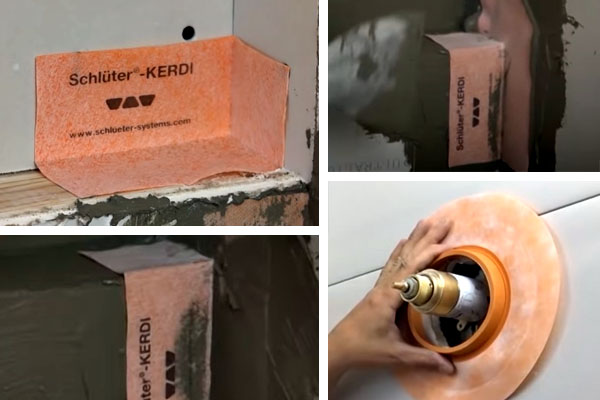
When it comes to bathroom renovations, there are a lot of different options you can choose from. One popular method is shower waterproofing. There are different types of waterproofing systems that you can use for this purpose, and each type has its own set of advantages and disadvantages depending on what you’re looking for. For instance, if your primary concern is leakage prevention or preventing water damage in general, one option might be more suitable than another.
Basically, four types of waterproofing membranes are used to make your shower area waterproof. These are:
Related:
- Do I Need to Waterproof Shower Walls and Floors Before Tiling?
- Wedi Shower System Reviews
- Mapei Aquadefense vs Redgard vs Hydro Ban
#1. Liquid Waterproofing Membrane

This is a thin coating containing a primer coat and topcoat. This waterproofing system involved using a special kind of paint designed to repel 98.99% of the water from its surface.
It has some pros and cons. For example, it can reach fragile sharp corners effortlessly. In cons, liquid waterproofing is extremely easily damaged, and even a tiny hole can destroy the whole system!
Some famous liquid waterproofing systems are following:
#2. Sheet Waterproofing Membrane

This is a waterproofing membrane in the form of sheet rolls. There are different types of sheet waterproofing products. These products are primarily differentiated by how they adapt to concrete surfaces. And so, we have torch-applied membranes and self-adhesive membranes. They are both used as roof waterproofing systems.
Another one is the synthetic fibers’ sheet membrane which is used as a shower waterproofing system. This system involves a thin sheet that reflects up to 98% of water away from its surface. It prevents moisture in the shower wall and flooring easily.
Some famous sheet waterproofing membranes are following:
#3. Waterproof Foam Wallboard
Waterproof foam wallboards are rigid panels that are made up of extruded polystyrene. Due to Extruded Polystyrene, they’re waterproof and water-resistant as well and are best to be used as a waterproofing base in your shower area. They also work as a tile backer on which you can install the tiles or any front-end material from which you want to cover the base.

Foam Shower Bases
Foam shower bases are the same as foam wallboards, but they’re a bit thicker and heavier than foam wallboards. However, unlike foam wallboards which cover the whole area, they only cover the bottom of your shower area (floor). Moreover, unlike foam wallboards, they don’t need tiling as well. They’re usually custom-designed according to the shape and placement of drainage in the shower area.
Foam-based waterproofing is the most common and reliable membrane to make the system waterproof. It’s the same membrane that is used in commercial buildings and small roofs to make them waterproof. The system can repel 99.99% of water away from its surface. It involves using Extruded Polystyrene or XPS foam which makes the kit highly resistive to the environment and completely waterproof.
Some famous waterproofing foam wallboard are following:
#4. Fiber Cement Backer Board

Fiber cement backer board is a long-lasting and low-maintenance material used to cover house exteriors. It is also sometimes used to cover commercial buildings. It is manufactured with sand and cement, and it contains cellulose fibers, making it durable.
Whether it can be used for a waterproofing system or not depends on the brand. Most of the brands of these durable boards have fiber reinforcement cement composition sheets, which are hard and waterproof.
Overall, foam membrane waterproofing is the far better according to most experts.
You might also like
Sources:
www.thespruce.com/cement-backer-board-1821658
www.waterproof.com/sealonce-diy-basement-waterproofing-system/















